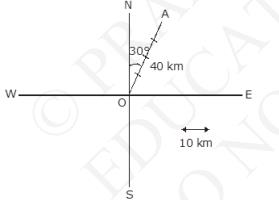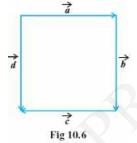Ex 10.1 class 12 maths ncert solutions | class 12 maths exercise 10.1 | class 12 maths ncert solutions chapter 10 exercise 10.1 | exercise 10.1 class 12 maths ncert solutions | class 12 maths chapter 10 ncert solutions | class 12 chapter 10 maths ncert solutions | vector algebra class 12 ncert solutions
Explore the complete and accurate Ex 10.1 Class 12 Maths NCERT Solutions to get a strong grip on the fundamentals of vectors. This exercise is part of Class 12 Maths Chapter 10 NCERT Solutions, focusing on the basics of vector quantities, magnitude, and direction. Our step-by-step Class 12 Maths Exercise 10.1 solutions simplify concepts, making learning easier for students. With clear explanations and solved examples, the Exercise 10.1 Class 12 Maths NCERT Solutions help you understand how to represent vectors geometrically and algebraically. Strengthen your preparation with these trusted Class 12 Chapter 10 Maths NCERT Solutions, which are part of the broader Vector Algebra Class 12 NCERT Solutions—a crucial topic for both board exams and competitive tests.

ex 10.1 class 12 maths ncert solutions || vector algebra class 12 ncert solutions || class 12 maths exercise 10.1 || class 12 chapter 10 maths ncert solutions || class 12 maths chapter 10 ncert solutions || exercise 10.1 class 12 maths ncert solutions || class 12 maths ncert solutions chapter 10 exercise 10.1
Exercise 10.1
Let \( \overrightarrow{\mathrm{OA}} \) be the displacement vector such that \( |\overrightarrow{\mathrm{OA}}|=40 \mathrm{~km} \)
Vector \( |\overrightarrow{O A}| \) makes an angle of \( 30^{\circ} \) east of North i.e. \( 30^{\circ} \) with North in North-East direction

2. Classify the following measures as scalars and vectors.
Vectors are defined as a quantity that has magnitude as well as direction.
\( \mathbf{1 0} \mathbf{~ k g} \) : It is a measure of mass. It is a scalar quantity as it has magnitude only and no direction.
ex 10.1 class 12 maths ncert solutions || vector algebra class 12 ncert solutions || class 12 maths exercise 10.1 || class 12 chapter 10 maths ncert solutions || class 12 maths chapter 10 ncert solutions || exercise 10.1 class 12 maths ncert solutions || class 12 maths ncert solutions chapter 10 exercise 10.1
Vectors are defined as a quantity that has magnitude as well as direction.
2 meters north-west: It is a measure of distance in a particular direction. \( \therefore \) It is a vector quantity as it has magnitude as well as direction.
Vectors are defined as a quantity that has magnitude as well as direction.
\( 40^{\circ} \) : It is a measure of angle. It is a scalar quantity as it has magnitude only and no direction.
Vectors are defined as a quantity that has magnitude as well as direction.
40 Watt: It is a measure of power. It is a scalar quantity as it has magnitude only and no direction.
ex 10.1 class 12 maths ncert solutions || vector algebra class 12 ncert solutions || class 12 maths exercise 10.1 || class 12 chapter 10 maths ncert solutions || class 12 maths chapter 10 ncert solutions || exercise 10.1 class 12 maths ncert solutions || class 12 maths ncert solutions chapter 10 exercise 10.1
Vectors are defined as a quantity that has magnitude as well as direction.
\( \mathbf{1 0}^{\mathbf{- 1 9}} \) coulomb: It is a measure of electric charge. It is a scalar quantity as it has magnitude only and no direction.
Vectors are defined as a quantity that has magnitude as well as direction.
\( \mathbf{2 0} \mathbf{~ m} / \mathbf{s e c}^{\mathbf{2}} \) : It is a measure of acceleration. It is a vector quantity as it is a measure of rate of change of velocity.
3. Classify the following as scalar and vector quantities.
Vectors are defined as a quantity that has magnitude as well as direction.
time period: It is a scalar quantity as it has magnitude only and no direction.
Vectors are defined as a quantity that has magnitude as well as direction.
distance: It is a scalar quantity as it has magnitude only and no direction.
Vectors are defined as a quantity that has magnitude as well as direction.
force: It is a vector quantity as it has magnitude as well as direction.
Vectors are defined as a quantity that has magnitude as well as direction.
velocity: It is a vector quantity as it has magnitude as well as direction.
Vectors are defined as a quantity that has magnitude as well as direction.
work done: It is a scalar quantity as it has magnitude as well as direction.
ex 10.1 class 12 maths ncert solutions || vector algebra class 12 ncert solutions || class 12 maths exercise 10.1 || class 12 chapter 10 maths ncert solutions || class 12 maths chapter 10 ncert solutions || exercise 10.1 class 12 maths ncert solutions || class 12 maths ncert solutions chapter 10 exercise 10.1
(i) Coinitial
(ii) Equal
(iii) Collinear but not equal


(i) Coinitial vectors: Two or more vectors having same initial point are called coinitial vectors.
So, in the above figure \( \overrightarrow{a} \) and \( \overrightarrow{d} \) are Coinitial vectors as they have same initial point.
\( \therefore \) Coinitial vectors: \( \overrightarrow{a} \) and \( \overrightarrow{d} \)
(ii) Equal vectors: Two or more vectors having same direction and same magnitude are called equal vectors.
So, in the above figure \( \overrightarrow{b} \) and \( \overrightarrow{d} \) are equal vectors as they have same magnitude and same direction.
\( \therefore \) Equal vectors: \( \overrightarrow{b} \) and \( \overrightarrow{d} \)
(iii) Collinear but not equal:
\( \because \overrightarrow{a} \) and \( \overrightarrow{c} \) are parallel vectors, so, they are collinear. But they have opposite direction, so, they are not equal.
Hence, \( \overrightarrow{a} \) and \( \overrightarrow{c} \) are collinear but not equal.
5. Answer the following as true or false.
Explanation: \( \overrightarrow{a} \) and \( -\overrightarrow{a} \) are parallel vectors, so, they are collinear.
Explanation: we know, \(\hat{i}\) and \( \hat{j} \) are unit vectors, so they have same magnitude but and are vectors along \(x- \) axis and \(y- \) axis respectively.
Explanation: Two or more vectors are said to be collinear if they are parallel to the same line, irrespective of their magnitudes and directions. We know, \(\hat{i}\) and \( \hat{j} \) are unit vectors, so they have same magnitude but and are vectors along \(x\) - axis and \(y\) - axis respectively. Since, they are not parallel to each other, so, they are not collinear.
Explanation: Two vector are said to be equal, if they have the same magnitude and direction.
\( \overrightarrow{b} \) and \( -\overrightarrow{b} \) are collinear vectors as they are parallel to each other and also they have same magnitude. But they do not have same direction, so, they are unequal vectors.
